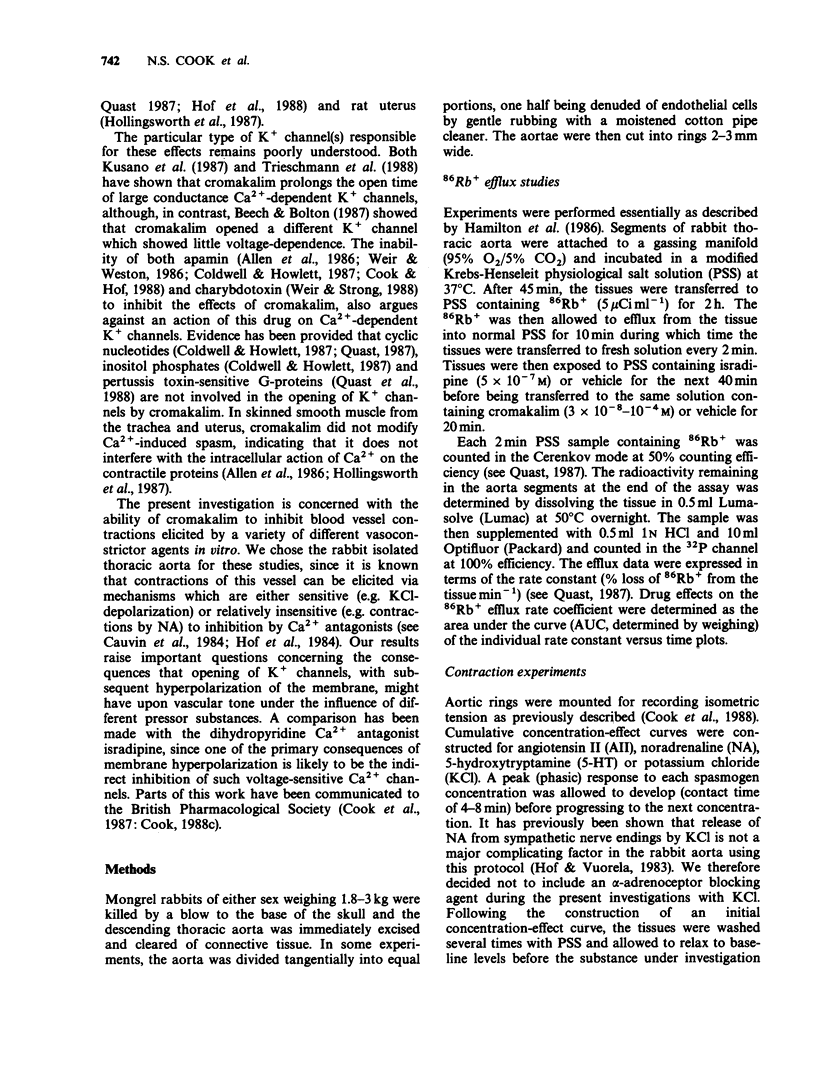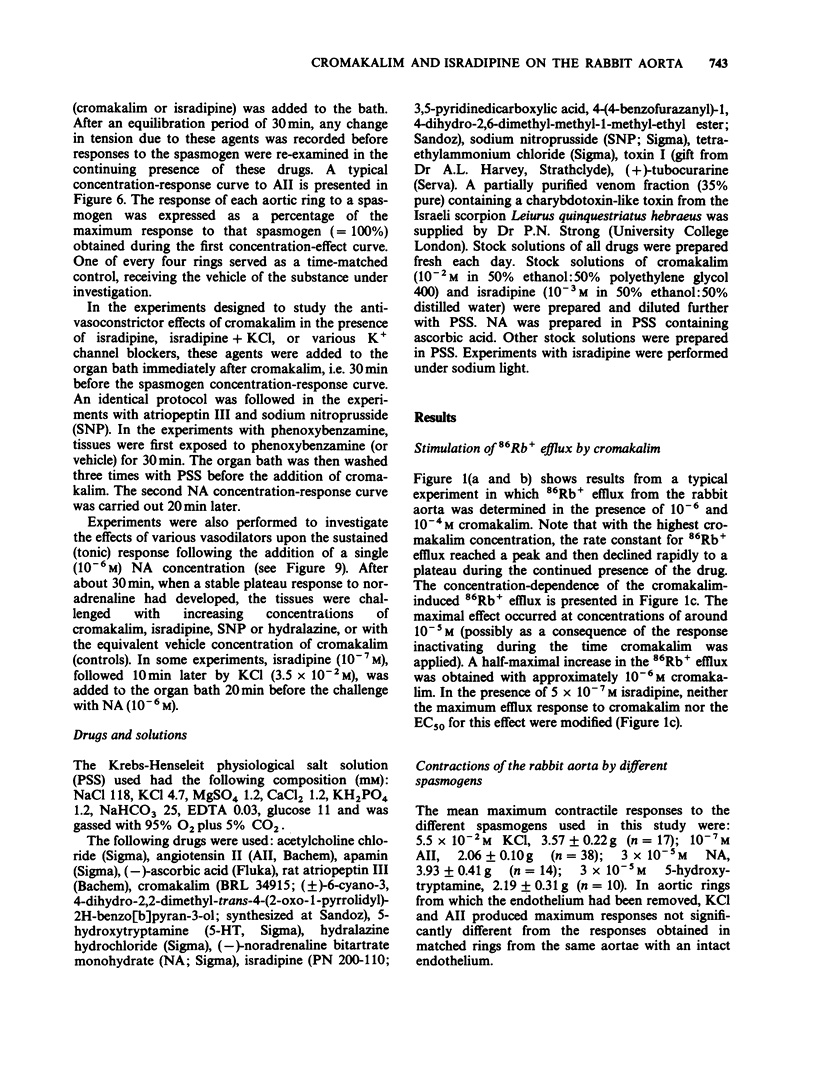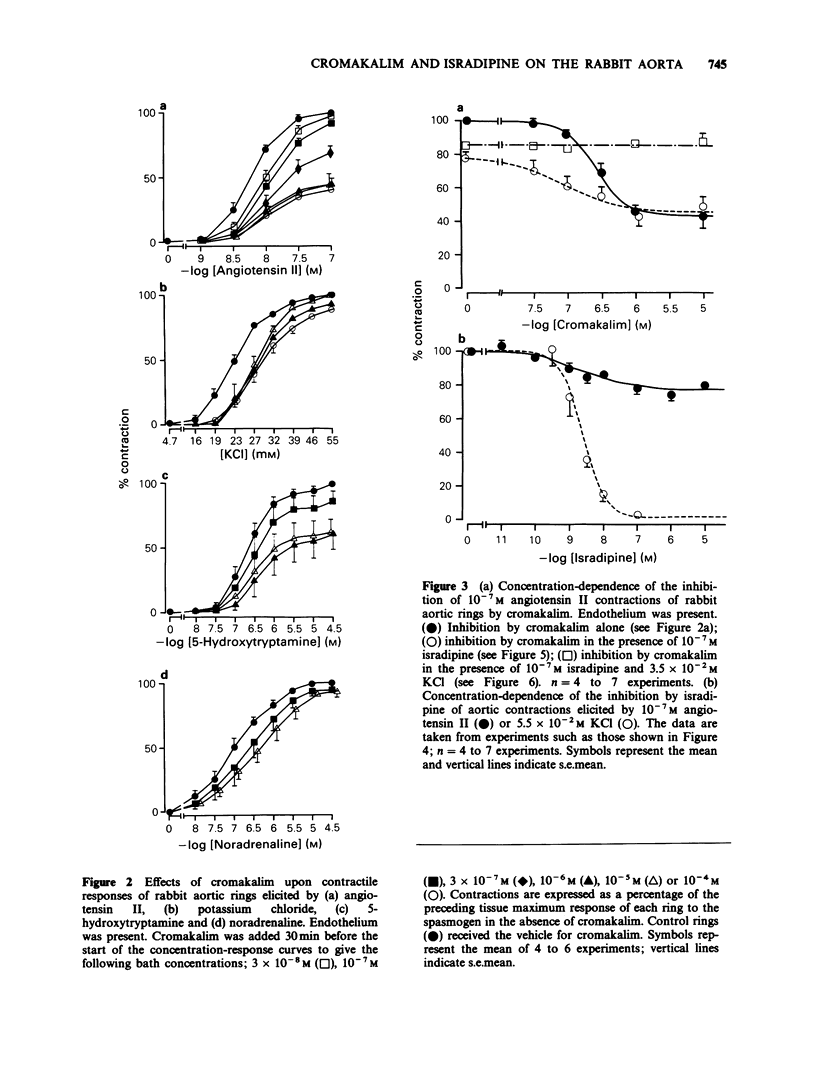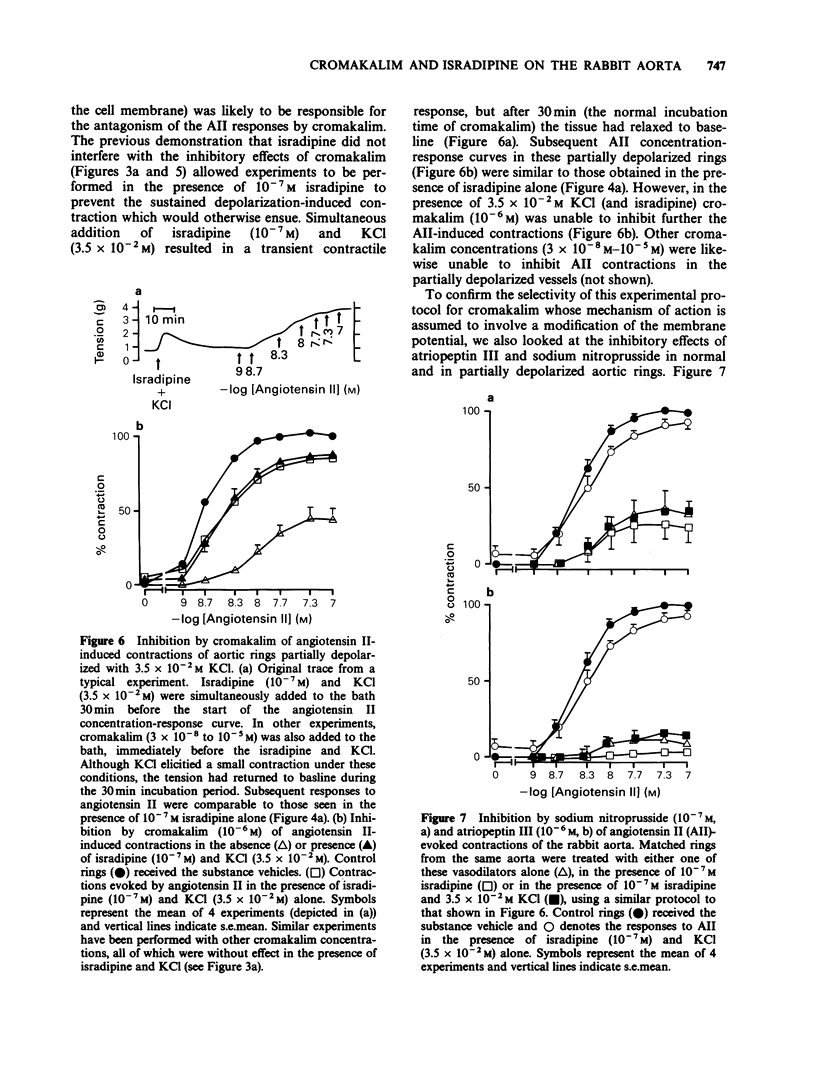Abstract
1. Contractile responses of rabbit aortic rings elicited by KCl-depolarization, angiotensin II (AII), 5-hydroxytryptamine (5-HT) and noradrenaline (NA) have been investigated in the presence of cromakalim (BRL 34915) and isradipine (PN 200-110). 2. Above 10(-6)M, cromakalim inhibited contractile responses to low (less than or equal to 32 mM) but not to higher KCl concentrations. The 5-HT and AII concentration-response curves were antagonized noncompetitively by cromakalim (10(-7)-10(-5)M) and the maximal responses were inhibited by 40 and 55%, respectively. 3. Isradipine caused less inhibition of AII and 5-HT contractile responses than cromakalim, and in the presence of isradipine (10(-7)M), cromakalim was still able to antagonize further the contractions to AII in this vessel. 4. NA-induced contractions were relatively insensitive to inhibition by cromakalim and isradipine, both drugs causing a small rightward shift of the NA concentration-response curve. This result suggests that NA utilizes different Ca2+ pools from those involved in AII- and 5-HT-induced contractions of this vessel. 5. The sustained (tonic) part of the NA response was inhibited in a concentration-dependent manner by cromakalim (10(-7)-10(-5)M), but not by isradipine. 6. In aortic rings partially depolarized with 3.5 x 10(-2)M KCl, the ability of cromakalim, but not of sodium nitroprusside, atriopeptin III or hydralazine, to inhibit AII- and tonic NA-induced contractions was abolished. 7. Antivasoconstrictor activity of cromakalim on the rabbit aorta appears to involve factors in addition to an indirect inhibition of Ca2+ entry through dihydropyridine-sensitive Ca2+ channels. 8. The ability of cromakalim to open K+ channels and thereby modify the membrane potential would appear to underlie these antivasoconstrictor effects. This mechanism of action of cromakalim clearly differs from that of other vasodilators such as sodium nitroprusside and hydralazine.
Full text
PDF











Selected References
These references are in PubMed. This may not be the complete list of references from this article.
- Allen S. L., Boyle J. P., Cortijo J., Foster R. W., Morgan G. P., Small R. C. Electrical and mechanical effects of BRL34915 in guinea-pig isolated trachealis. Br J Pharmacol. 1986 Oct;89(2):395–405. doi: 10.1111/j.1476-5381.1986.tb10273.x. [DOI] [PMC free article] [PubMed] [Google Scholar]
- Bean B. P., Sturek M., Puga A., Hermsmeyer K. Calcium channels in muscle cells isolated from rat mesenteric arteries: modulation by dihydropyridine drugs. Circ Res. 1986 Aug;59(2):229–235. doi: 10.1161/01.res.59.2.229. [DOI] [PubMed] [Google Scholar]
- Benham C. D., Tsien R. W. A novel receptor-operated Ca2+-permeable channel activated by ATP in smooth muscle. Nature. 1987 Jul 16;328(6127):275–278. doi: 10.1038/328275a0. [DOI] [PubMed] [Google Scholar]
- Bolton T. B. Mechanisms of action of transmitters and other substances on smooth muscle. Physiol Rev. 1979 Jul;59(3):606–718. doi: 10.1152/physrev.1979.59.3.606. [DOI] [PubMed] [Google Scholar]
- Brading A. F., Lategan T. W. Na-Ca exchange in vascular smooth muscle. J Hypertens. 1985 Apr;3(2):109–116. doi: 10.1097/00004872-198504000-00002. [DOI] [PubMed] [Google Scholar]
- Cauvin C., Lukeman S., Cameron J., Hwang O., Meisheri K., Yamamoto H., van Breemen C. Theoretical bases for vascular selectivity of Ca2+ antagonists. J Cardiovasc Pharmacol. 1984;6 (Suppl 4):S630–S638. doi: 10.1097/00005344-198406004-00009. [DOI] [PubMed] [Google Scholar]
- Coldwell M. C., Howlett D. R. Specificity of action of the novel antihypertensive agent, BRL 34915, as a potassium channel activator. Comparison with nicorandil. Biochem Pharmacol. 1987 Nov 1;36(21):3663–3669. doi: 10.1016/0006-2952(87)90017-7. [DOI] [PubMed] [Google Scholar]
- Collins G. G., Dewhurst D. G. Sites and mechanisms of action of catechol (1,2-dihydroxybenzene) in the rat olfactory cortex slice. Br J Pharmacol. 1986 Jun;88(2):433–440. doi: 10.1111/j.1476-5381.1986.tb10221.x. [DOI] [PMC free article] [PubMed] [Google Scholar]
- Cook N. S., Hof R. P. Cardiovascular effects of apamin and BRL 34915 in rats and rabbits. Br J Pharmacol. 1988 Jan;93(1):121–131. doi: 10.1111/j.1476-5381.1988.tb11412.x. [DOI] [PMC free article] [PubMed] [Google Scholar]
- Cook N. S., Quast U., Hof R. P., Baumlin Y., Pally C. Similarities in the mechanism of action of two new vasodilator drugs: pinacidil and BRL 34915. J Cardiovasc Pharmacol. 1988 Jan;11(1):90–99. doi: 10.1097/00005344-198801000-00014. [DOI] [PubMed] [Google Scholar]
- Cook N. S. The pharmacology of potassium channels and their therapeutic potential. Trends Pharmacol Sci. 1988 Jan;9(1):21–28. doi: 10.1016/0165-6147(88)90238-6. [DOI] [PubMed] [Google Scholar]
- Friedman M. E., Suarez-Kurtz G., Kaczorowski G. J., Katz G. M., Reuben J. P. Two calcium currents in a smooth muscle cell line. Am J Physiol. 1986 Apr;250(4 Pt 2):H699–H703. doi: 10.1152/ajpheart.1986.250.4.H699. [DOI] [PubMed] [Google Scholar]
- Hamilton T. C., Weir S. W., Weston A. H. Comparison of the effects of BRL 34915 and verapamil on electrical and mechanical activity in rat portal vein. Br J Pharmacol. 1986 May;88(1):103–111. doi: 10.1111/j.1476-5381.1986.tb09476.x. [DOI] [PMC free article] [PubMed] [Google Scholar]
- Hof R. P., Quast U., Cook N. S., Blarer S. Mechanism of action and systemic and regional hemodynamics of the potassium channel activator BRL34915 and its enantiomers. Circ Res. 1988 Apr;62(4):679–686. doi: 10.1161/01.res.62.4.679. [DOI] [PubMed] [Google Scholar]
- Hof R. P., Scholtysik G., Loutzenhiser R., Vuorela H. J., Neumann P. PN 200-110, a new calcium antagonist: electrophysiological, inotropic, and chronotropic effects on guinea pig myocardial tissue and effects on contraction and calcium uptake of rabbit aorta. J Cardiovasc Pharmacol. 1984 May-Jun;6(3):399–406. [PubMed] [Google Scholar]
- Hof R. P., Vuorela H. J. Assessing calcium antagonism on vascular smooth muscle: a comparison of three methods. J Pharmacol Methods. 1983 Feb;9(1):41–52. doi: 10.1016/0160-5402(83)90049-9. [DOI] [PubMed] [Google Scholar]
- Hollingsworth M., Amédée T., Edwards D., Mironneau J., Savineau J. P., Small R. C., Weston A. H. The relaxant action of BRL 34915 in rat uterus. Br J Pharmacol. 1987 Aug;91(4):803–813. doi: 10.1111/j.1476-5381.1987.tb11279.x. [DOI] [PMC free article] [PubMed] [Google Scholar]
- Lodge N. J., van Breemen C. Mobilization of extracellularly bound Ca2+ during high K+ and norepinephrine stimulation of the rabbit aorta. Blood Vessels. 1985;22(5):234–243. doi: 10.1159/000158607. [DOI] [PubMed] [Google Scholar]
- Quast U. Effect of the K+ efflux stimulating vasodilator BRL 34915 on 86Rb+ efflux and spontaneous activity in guinea-pig portal vein. Br J Pharmacol. 1987 Jul;91(3):569–578. doi: 10.1111/j.1476-5381.1987.tb11250.x. [DOI] [PMC free article] [PubMed] [Google Scholar]
- Quast U., Scholtysik G., Weir S. W., Cook N. S. Pertussis toxin treatment does not inhibit the effects of the potassium channel opener BRL 34915 on rat isolated vascular and cardiac tissues. Naunyn Schmiedebergs Arch Pharmacol. 1988 Jan;337(1):98–104. doi: 10.1007/BF00169484. [DOI] [PubMed] [Google Scholar]
- Ruffolo R. R., Jr, Morgan E. L., Messick K. Possible relationship between receptor reserve and the differential antagonism of alpha-1 and alpha-2 adrenoceptor-mediated pressor responses by calcium channel antagonists in the pithed rat. J Pharmacol Exp Ther. 1984 Sep;230(3):587–594. [PubMed] [Google Scholar]
- Siegl P. K., Cragoe E. J., Jr, Trumble M. J., Kaczorowski G. J. Inhibition of Na+/Ca2+ exchange in membrane vesicle and papillary muscle preparations from guinea pig heart by analogs of amiloride. Proc Natl Acad Sci U S A. 1984 May;81(10):3238–3242. doi: 10.1073/pnas.81.10.3238. [DOI] [PMC free article] [PubMed] [Google Scholar]
- Timmermans P. B., Thoolen M. J., Mathy M. J., Wilffert B., de Jonge A., van Zwieten P. A. Effects of the irreversible alpha-adrenoceptor antagonists phenoxybenzamine and benextramine on the effectiveness of nifedipine in inhibiting alpha 1- and alpha 2-adrenoceptor mediated vasoconstriction in pithed rats. Naunyn Schmiedebergs Arch Pharmacol. 1985 Jun;329(4):404–413. doi: 10.1007/BF00496376. [DOI] [PubMed] [Google Scholar]
- Weir S. W., Weston A. H. Effect of apamin on responses to BRL 34915, nicorandil and other relaxants in the guinea-pig taenia caeci. Br J Pharmacol. 1986 May;88(1):113–120. doi: 10.1111/j.1476-5381.1986.tb09477.x. [DOI] [PMC free article] [PubMed] [Google Scholar]


